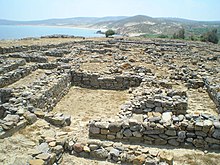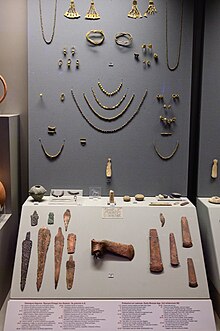239:
445:
427:
454:
418:
57:
436:
391:
400:
409:
463:
50:
472:
34:
297:. He clarified the stratigraphy by assigning colors to different phases of the settlement. There are seven numbered phases altogether, and the names are given here in Italian, as well as English. Black/Nero (I), Blue/Azzurro (II), Green/Verde (III), Red/Rosso (IV), Yellow/Giallo (V), Brown/Bruno (VI), and Mycenaean (VII).
342:
This period, like the previous one, has 7 construction phases. Now is the first appearance of metal items. The finds include pins, awls, and a dagger. A mould for a shaft-hole axe has also been found, which indicates local casting of various tools. Stamp seals also appear at this period. This phase
367:
The yellow period features a large fortified town. Houses are constructed as large multi-roomed blocks with megaron units at the core. These architectural ensembles are quite different in detail from the corresponding architecture of Troy I-II, or Thermi III-V. Similar to Troy IIg, a lot of gold
305:
This period corresponds to the Early Bronze I period in the Aegean. It has 7 different levels of construction, thus testifying to a long and continuous occupation over a long period. The villages during this phase consist of huts that are generally round or oval in shape with stone bases.
309:
For this period, the site has only been excavated under megaron 605 and megaron 832. Under megaron 832, excavations have shown 7 consecutive layers over 2 meters in depth. Under the megaron 605, only 3 levels are visible.
335:
It follows the black period, and we notice during this period an enlargement of the city with the construction of a defensive wall. There's also the construction of a typically Cretan
368:
jewellery was found. An imported cylinder seal was also found. This phase was contemporary with late Troy II, and Troy III. There may also be some correspondences with Troy IV.
359:
This period has 4 to 8 different architectural phases. A hoard of bronze items was found from this period that includes a shaft-hole axe, daggers and other tools and weapons.
281:
took place, the Greeks had a permanent settlement there, rather than just a commercial outpost, understanding the importance of the straits connecting the Aegean and the
444:
238:
647:
265:
situated in the
Moudros harbour, west of Poliochne. This settlement was developed circa 2000-1650 BC, and the findings again prove commercial ties with
219:
632:
351:
This is the shortest period of the site, but it may be associated with Troy I or II, through ceramics. It has only 3 architectural phases.
556:
Past
Stories – Modern Narratives: Cultural Dialogues between East Aegean Islands and the West Anatolian Mainland in the 4th Millennium BC.
608:
Benvenuti, Alberto; Tine, Vincenzo; Traverso, Antonella (2022). "Πολιόχνη. Μιὰ νέα ἀνάγνωση τῆς οἰκιστικῆς ἐξέλιξης τῆς ΠΕΧ Ι-IΙ".
104:
426:
662:
531:
He
Poliochne kai he proime epoche tou Chalkou sto Voreio Aigaio/Poliochni e l'antica et del bronzo nell'Egeo settentrionale
313:
As for the ceramics, it has painted decorations, white in color, with linear patterns. There are some similarities to the
250:) in 1931-36, when they were suspended. Following Della Seta's death, excavations were resumed in 1951-53, 1956 and 1960.
49:
512:
Rome, vol. I (1964), having assigned arbitrary color-names to the strata, coordinated Troy I with the third period (
555:
417:
327:(very close by), have also been excavated recently. Myrina is considered contemporary with Poliochni Black period.
453:
652:
657:
591:
579:
567:
542:
277:
ceramics of the 13th century BC found on
Koukonesi could prove that, around when the traditional era of the
294:
408:
390:
462:
435:
399:
247:
84:
20:
246:
Following initial soundings, regular campaigns at
Poliochne were undertaken under A. Della Seta (
230:
was its main rival commercially; a rivalry that led to the decline of
Poliochne circa 2000 BC.
200:
314:
274:
208:
627:
379:
Poliochni is resettled during the Brown period, which may be contemporary with Troy V.
320:
254:
184:
168:
343:
may correspond to early Troy I (Renfrew), or to the Troy I/II transition (Podzuweit).
641:
471:
196:
203:
and is believed to be one of the most ancient towns in Europe, preceding Troy I.
215:
278:
270:
266:
258:
214:
The site, with houses huddled together sharing party walls, was unearthed by
119:
106:
324:
282:
262:
592:
Lesson 7: Western
Anatolia and the Eastern Aegean in the Early Bronze Age.
580:
Lesson 7: Western
Anatolia and the Eastern Aegean in the Early Bronze Age.
568:
Lesson 7: Western
Anatolia and the Eastern Aegean in the Early Bronze Age.
543:
Lesson 7: Western
Anatolia and the Eastern Aegean in the Early Bronze Age.
207:
features of the earliest layers were affected by cultural influences from
204:
485:
336:
33:
339:, testifying to an exchange between Crete and the city of Poliochni.
192:
92:
88:
237:
227:
191:), was an ancient settlement on the east coast of the island of
371:
A gap in occupation has been detected after the Yellow period.
525:
Site publications, such as S. Tibne, A.G. Benevuti, et al.,
293:
From 1951 the site was excavated under the direction of
529:, Athens 1994, and C.G. Doumas and V. La Rosa (eds.),
152:
20th Ephorate of Prehistoric and Classical Antiquities
211:, about the start of Early Helladic II, ca. 2500 BC.
164:
156:
148:
143:
135:
98:
80:
72:
506:Poliochni, città peristorica nell' isola di Lemnos
242:Bronze Age finds from Poliochne, 3rd millennium BC
516:) of Poliochne; vol. II was published Rome, 1976.
504:Luigi Bernabò-Brea, ed. (the head excavator)
261:settlement on the tiny uninhabited island of
19:Not to be confused with a small village near
8:
26:
16:Archaeological site on Lemnos island, Greece
226:), beginning in 1930. It is believed that
32:
25:
497:
386:
220:Italian School of Archaeology at Athens
527:Oi neoteres anaskaphese sten Poliochne
224:Scuola archeologica Italiana di Athene
38:Remains of building walls at Poliochne
7:
179:, often cited under its modern name
14:
648:Former populated places in Greece
56:
470:
461:
452:
443:
434:
425:
416:
407:
398:
389:
169:Archaeological Site of Poliochni
55:
48:
533:have appeared in Greek/Italian.
1:
510:Scuola Archeologica di Atene
679:
18:
257:discovered a more recent
188:
43:
31:
253:During 1994-1997, Greek
195:. It was settled in the
323:, also on Lemnos, and
273:and mainland Greece.
243:
663:Cycladic civilization
610:Ἀρχαιολογικὴ Ἐφημερίς
241:
120:39.85417°N 25.34361°E
73:Alternative name
554:Ourania Kouka 2014,
116: /
64:Shown within Greece
28:
21:Livadochori, Lemnos
295:Luigi Bernabò Brea
244:
157:Public access
125:39.85417; 25.34361
558:aegeussociety.org
201:Aegean Bronze Age
197:Late Chalcolithic
174:
173:
670:
633:Limnos - History
628:Official website
617:
595:
589:
583:
577:
571:
565:
559:
552:
546:
540:
534:
523:
517:
502:
474:
465:
456:
447:
438:
429:
420:
411:
402:
393:
315:Eutresis culture
190:
131:
130:
128:
127:
126:
121:
117:
114:
113:
112:
109:
59:
58:
52:
36:
29:
678:
677:
673:
672:
671:
669:
668:
667:
653:Mycenaean sites
638:
637:
624:
607:
604:
599:
598:
590:
586:
578:
574:
566:
562:
553:
549:
541:
537:
524:
520:
503:
499:
494:
482:
475:
466:
457:
448:
439:
430:
421:
412:
403:
394:
385:
377:
365:
357:
349:
333:
303:
291:
236:
209:Helladic Greece
124:
122:
118:
115:
110:
107:
105:
103:
102:
68:
67:
66:
65:
62:
61:
60:
39:
24:
17:
12:
11:
5:
676:
674:
666:
665:
660:
658:Ancient Lemnos
655:
650:
640:
639:
636:
635:
630:
623:
622:External links
620:
619:
618:
603:
600:
597:
596:
584:
572:
560:
547:
535:
518:
496:
495:
493:
490:
489:
488:
481:
478:
477:
476:
469:
467:
460:
458:
451:
449:
442:
440:
433:
431:
424:
422:
415:
413:
406:
404:
397:
395:
388:
384:
381:
376:
373:
364:
361:
356:
353:
348:
345:
332:
329:
302:
299:
290:
287:
271:Aegean islands
255:archaeologists
235:
232:
172:
171:
166:
162:
161:
158:
154:
153:
150:
146:
145:
141:
140:
137:
133:
132:
100:
96:
95:
82:
78:
77:
74:
70:
69:
63:
54:
53:
47:
46:
45:
44:
41:
40:
37:
15:
13:
10:
9:
6:
4:
3:
2:
675:
664:
661:
659:
656:
654:
651:
649:
646:
645:
643:
634:
631:
629:
626:
625:
621:
615:
611:
606:
605:
601:
594:dartmouth.edu
593:
588:
585:
582:dartmouth.edu
581:
576:
573:
570:dartmouth.edu
569:
564:
561:
557:
551:
548:
545:dartmouth.edu
544:
539:
536:
532:
528:
522:
519:
515:
511:
507:
501:
498:
491:
487:
484:
483:
479:
473:
468:
464:
459:
455:
450:
446:
441:
437:
432:
428:
423:
419:
414:
410:
405:
401:
396:
392:
387:
382:
380:
374:
372:
369:
363:Yellow period
362:
360:
354:
352:
346:
344:
340:
338:
330:
328:
326:
322:
318:
316:
311:
307:
300:
298:
296:
289:Periodisation
288:
286:
284:
280:
276:
272:
268:
264:
260:
256:
251:
249:
240:
233:
231:
229:
225:
221:
217:
212:
210:
206:
202:
199:and earliest
198:
194:
186:
182:
178:
170:
167:
163:
159:
155:
151:
147:
142:
138:
134:
129:
101:
97:
94:
90:
86:
83:
79:
75:
71:
51:
42:
35:
30:
22:
613:
609:
602:Bibliography
587:
575:
563:
550:
538:
530:
526:
521:
513:
509:
505:
500:
378:
375:Brown period
370:
366:
358:
350:
347:Green period
341:
334:
319:
312:
308:
304:
301:Black Period
292:
252:
245:
223:
213:
180:
176:
175:
331:Blue Period
269:, and with
234:Archaeology
216:excavations
123: /
99:Coordinates
642:Categories
355:Red period
317:ceramics.
279:Trojan War
267:Asia Minor
259:Bronze Age
149:Management
144:Site notes
139:Settlement
111:25°20′37″E
108:39°51′15″N
616:: 85–140.
325:Koukonesi
283:Black Sea
275:Mycenaean
263:Koukonesi
205:Anatolian
181:Poliochni
177:Poliochne
85:Poliochni
76:Poliochni
27:Poliochne
480:See also
189:Πολιόχνη
81:Location
486:Skarkos
383:Gallery
337:megaron
218:of the
165:Website
321:Myrina
193:Lemnos
93:Greece
89:Lemnos
514:Verde
492:Notes
185:Greek
228:Troy
136:Type
614:161
508:, (
160:Yes
644::
612:.
285:.
248:it
187::
91:,
87:,
222:(
183:(
23:.
Text is available under the Creative Commons Attribution-ShareAlike License. Additional terms may apply.


